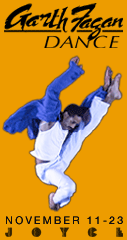
 |

|
 |

|
 |
 |
 |
 |
Go back to Flash Reviews De Mille, Ashton, Forsythe, Duato Highlight ABT Opening Week By Susan Yung NEW YORK -- American Ballet Theatre's fall season at City Center, expanded to three weeks from the usual two, offers the company a chance to perform smaller-scale works and oddities that might not fit into the grander scheme of its spring Met engagement. The season-opening gala last Wednesday cherry-picked the lightest and most classical of this season's repertory, exemplified in, respectively, a premiere of Christian Spuck's "Le Grand Pas de Deux" and a revival of Balanchine's "Theme and Variations." The evening opened with Agnes de Mille's "Three Virgins and a Devil," to Respighi, in the version choreographed for Ballet Theatre in 1941, staged here by Dennis Nahat. Erica Fischbach, Adrienne Schulte, and Kelley Waddell, as the virgins with varying degrees of piety, executed with detail de Mille's mime-filled movement. Carlos Molina sauced up his portayal of the devil with big grimaces, clutching his long tail or letting it whip out centrifugally. Next came Frederick Ashton's "Symphonic Variations," to Cesar Franck's score, created in 1946 on Margot Fonteyn and Michael Somes of the Sadler's Wells (now Royal) Ballet and premiered by them in this country 54 years ago this month. For this staging, by Wendy Ellis Somes, Max Beloserkovsky and Ashley Tuttle led the cast of six. The astringent yellow backdrop with graphic black lines set the tone for the choreography, which featured stiffly-held arms above and below a side-bent torso, flat-footed arabesques, and lifts in which Tuttle skimmed inches off the floor. "Theme and Variations," choreographed on ABT in 1947, featured Paloma Herrera and Marcelo Gomes accompanied by 24 dancers in pastille-hued tutus and waistcoats. Herrera and Gomes laid down the leitmotif of this fundamentals-at-heart work: tendu, change directions one-quarter, repeat. It travels through degages and ballones and more tendus, with slightly shifting epaulements and arm combinations to give varying refined tones to each phrase. Gomes effortlessly executed a tough sequence of eight alternating tours en l'air and pirouettes. Herrera danced with her exemplary technical prowess (if usual detachment, but more on that later), particularly in a mesmerizing phrase in which she was "partnered" in arabesque by 12 women bourree-ing through spiral shapes, shifting minutely and incessantly, like a Swiss watch movement. In Spuck's pas, from 1999, Vladimir Malakhov spoofed his image as an ice king; he paired with the very game Xiomara Reyes as an adorable dork who sported eyeglasses and carried a purse, at times between her teeth. A plastic cow wearing a tutu and tiara sat upstage while the couple goosed traditional partnering protocol, acting out feelings which no doubt usually simmer behind saccharine smiles. Irina Dvorovenko and Angel Corella, who both exude a sweet demeanor onstage, danced Balanchine's "Tchaikovsky Pas de Deux." Dvorovenko -- all romantic fluidity and lightness -- tenderly drew out each phrase. Corella beamed, looking pleased to be back onstage, though he didn't completely control the mixed blessing of unlimited adrenaline. Gillian Murphy and Jose Manuel Carreno made for a most electric combination in Vaganova's "Diana & Acteon" pas de deux and coda, in Rudolf Nureyev's staging. Murphy seemed to reconcile opposites, her dancing clean, lush, strong, and fragile all in one phrase. Carreno seems to keep getting better, springing into arcing leaps, throwing Murphy into another atmosphere, and finishing six turns by simply staying on releve. On Saturday evening, the company presented what it's calling its "innovative" program (the season's other three programs are branded "master works," "contemporary," and "family friendly"), featuring works by Nacho Duato and William Forsythe, both serious, major contributors to the contemporary repertory. Both choreographers reward the sculptural, flexible ballet body, and, particularly, shapely feet, found in abundance at ABT. Last year's George Harrison tribute rounded out the bill. "Without Words," created in 1998 for ABT by Duato to music by Schubert, featured eight couples costumed in beige, pin-tucked unitards and briefs. Black and white still photographs of the dancers were projected onto the backdrop, changing with each scene. Angel Corella, Sandra Brown, and Gennadi Saveliev performed precision work, one's extended leg just sweeping over another's lowered head. Brown, with a velvety movement style, shines in soft, sculptural choreography such as this. Paloma Herrera made for a wonderfully graphic figure, her pliant, soft-shoed feet adding a striking finish to her bold lines. Carlos Molina, Murphy, Reyes, and Malakhov rounded out the cast. Each couple performed unique, poetic duets toward the end, passing through the choreographer's signature flexed-foot and -limb shapes. Duato implied intimacy through subtle gestures and the use of music, rather than miming or playacting. Molina and Malakhov seemed unable to completely shake off the danseur noble cloak, at times automatically snapping into first position at rest instead of parallel, and self-consciously correcting (uncorrecting?) themselves. All those years of studying ballet so its unnatural positions are reflexive proved a bit of a challenge to overcome. That was so as well in "workwithinwork" by Forsythe, to Berio violin music, premiered by his company, Ballett Frankfurt, in 1998. In general, the ABT dancers handled his difficult, distinctive style well; a few even took to it impressively. Carlos Lopez, a soloist on the rise, danced a darting, quicksilver solo like he was born to do it, although his choreography departed from classical ballet more than the rest of the piece. Herrera looked quite at home with the angular vocabulary, jutting out her hip and finding added stretch in each position. Herrera, a technician, often seems remote, and in this case it served her extremely well. David Hallberg, Carmen Corella, and Eric Underwood seemed at ease in the choreography. Small but significant differences exist between ABT's and Ballett Frankfurt's style in Forsythe's choreography. When ABT's dancers look at one another onstage, they establish an emotional connection, while Frankfurt's as much observe one another as scientific research, and then look as if they move in reaction to what they just saw. The Frankfurt dancers hit their positions on time and then they find something extra in the position while somehow staying on beat, as if physically analyzing the position. The ABT company didn't seem entirely comfortable pushing past the demanding movement to find the extra inch of extension, or stretch of a joint. And, quite naturally, they haven't mastered Forsythe's quirky hand positions, sometimes defaulting to ballet's standard. Still, it's a measure of ABT's skill that Forsythe entrusted the company with a challenging, rewarding work that is so distinctly his own. (He even allowed the men to wear his signature socks over their soft shoes.) The program was completed by the George Harrison tribute, "Within You Without You," previously reviewed here. Notable additions to the cast included Marcelo Gomes, who, in the title song, combined to good effect his slinky cobra-like posture -- chest concave, head jutting forward -- with his flair for the dramatic. |
|||||||


